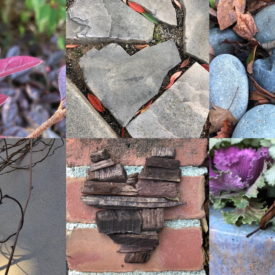How To Do It
This activity directs us to use our sense of sight to uncover what might not be readily seen. Step outside — or if the weather’s not exactly cooperating, you can try this indoors. Taking a picture of each find is a great way to tally up how many hearts you see.
Encourage your little one to look high and low, behind and under different objects: does the bark on that tree grow in a cool pattern? What’s under that pile of leaves?
If snow currently blankets your world, it might be more challenging to find heart shapes. Instead, create treasures for each other to find. Gather sticks of different lengths and lay them out in a heart or use one to draw a heart in the snow. Paint flat rocks with colorful hearts to leave around the neighborhood for others to find or if it’s a clear day, search out heart-shaped cloud formations.
The Power of Observation
When kids turn on their powers of observation, they often come up with delightful insights and share a perspective we might miss. On a recent treasure hunt with my 7-year-old daughter she showed me how simply changing your perspective reveals the unexpected.
A dormant vine clinging to the side of our house didn’t seem like much at first, but when my daughter noticed the way a thin branch curved and looped, she adjusted her point of view until it blended with the rest of the leafless plant to look like a heart (see the photo above for a sample of our finds and a hand-made creation).
Now, when we step outside, we see “found hearts” all around us and point out new ones when we walk the dog or play in the park. Noticing new hearts as the seasons change is especially exciting and motivating. Enjoy your heart-shaped hunt!
The Science Behind the Smiles
Besides enjoying the benefits of fresh air, being outdoors together is a great time to be in the moment with your child and notice the ways nature helps us use our senses to connect with the environment.
How to Tap Into Your Five Senses to Find Peace and Be Present (Shape)



